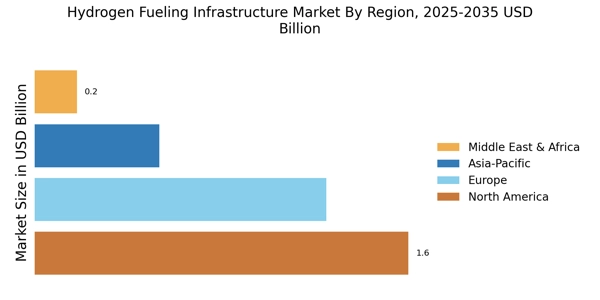Expansion of Renewable Energy Sources
The Hydrogen Fueling Infrastructure Market is closely linked to the expansion of renewable energy sources, which are increasingly being utilized for hydrogen production. The integration of wind, solar, and hydroelectric power into hydrogen production processes is expected to enhance the sustainability of hydrogen fueling stations. As renewable energy capacity continues to grow, the cost of producing green hydrogen is anticipated to decrease, potentially making hydrogen fueling more accessible. Reports indicate that the share of renewable energy in hydrogen production could reach 30% by 2030, further driving the demand for hydrogen fueling infrastructure.
Collaborations Between Industry Stakeholders
The Hydrogen Fueling Infrastructure Market is witnessing an increase in collaborations among various stakeholders, including automotive manufacturers, energy companies, and technology providers. These partnerships are essential for developing and deploying hydrogen fueling infrastructure efficiently. By pooling resources and expertise, stakeholders can accelerate the establishment of hydrogen stations and enhance the overall market ecosystem. Recent collaborations have led to the establishment of joint ventures aimed at expanding hydrogen networks, which could potentially double the number of operational fueling stations within the next decade.
Technological Innovations in Fueling Systems
Technological innovations are playing a crucial role in shaping the Hydrogen Fueling Infrastructure Market. Advances in fueling systems, such as improved storage solutions and faster refueling technologies, are making hydrogen fueling more efficient and user-friendly. Innovations like high-pressure hydrogen dispensers and automated fueling systems are expected to enhance the customer experience and increase the attractiveness of hydrogen as a fuel option. As these technologies continue to evolve, they may lead to a significant reduction in fueling times, thereby encouraging more widespread adoption of hydrogen fuel cell vehicles.
Rising Consumer Awareness of Environmental Issues
Consumer awareness regarding environmental issues is significantly influencing the Hydrogen Fueling Infrastructure Market. As individuals become more conscious of their carbon footprints, there is a growing preference for cleaner transportation options, including hydrogen fuel cell vehicles. This shift in consumer behavior is likely to drive demand for hydrogen fueling stations, as more drivers seek convenient access to hydrogen fuel. Market analysis suggests that the number of hydrogen fuel cell vehicles could exceed 2 million by 2030, necessitating a corresponding increase in fueling infrastructure to meet this demand.
Increasing Government Support for Hydrogen Initiatives
The Hydrogen Fueling Infrastructure Market is experiencing a notable surge in government support, as various nations implement policies aimed at promoting hydrogen as a clean energy source. This support often manifests in the form of subsidies, tax incentives, and funding for research and development. For instance, several countries have set ambitious targets for hydrogen production and utilization, which could lead to a projected increase in hydrogen fueling stations by over 50% in the next five years. Such initiatives not only bolster the infrastructure but also enhance public confidence in hydrogen technologies, thereby accelerating market growth.


















Leave a Comment